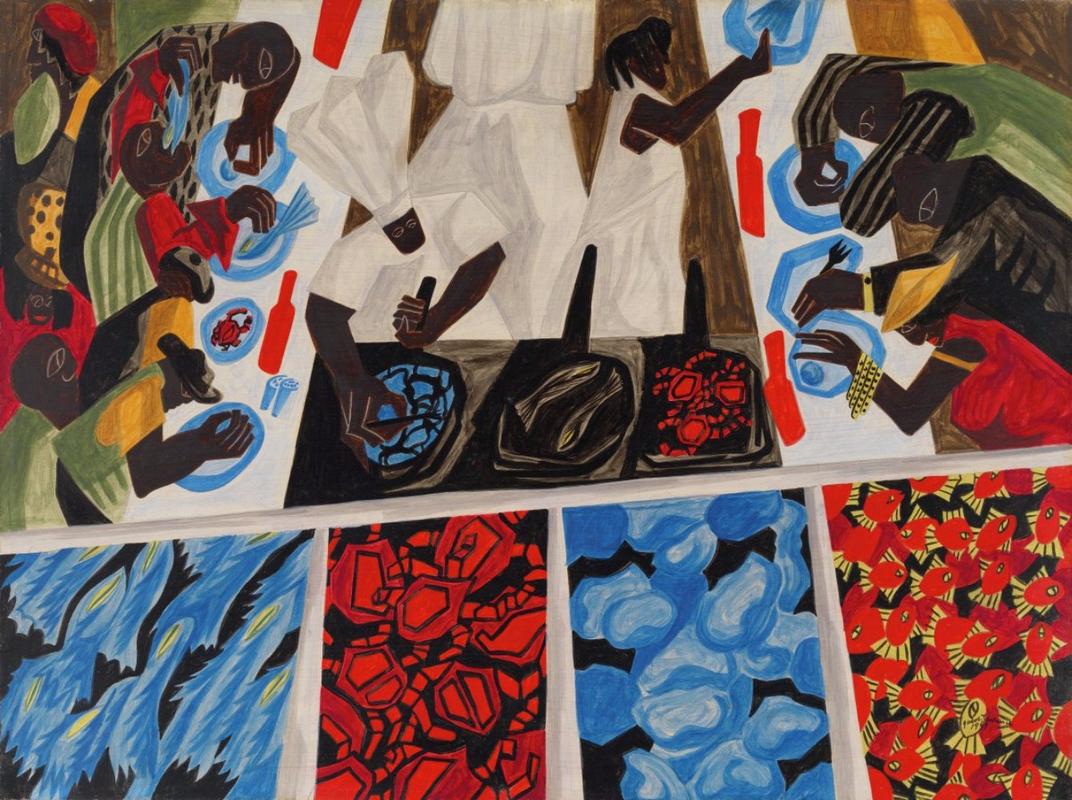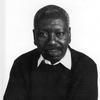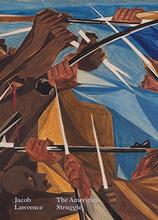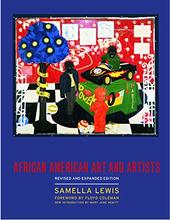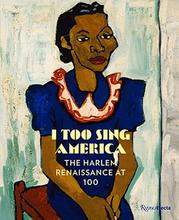More about Catfish Row
- All
- Info
- Shop

Contributor
Come grab a bite to eat on Catfish Row!
Jacob Lawrence’s painting Catfish Row may be based on “Cabbage Row,” a historic section of Church Street in Charleston, Virginia, alongside the sea. Cabbage Row got its name from the African American families of freed slaves who sold cabbage from their window sills to local passersby (convenient and healthy!) during the late 19th Century. The name change from “cabbage” to “catfish” comes from Dubose Heyward’s novel Porgy and the subsequent Gershwin opera, Porgy & Bess, both hugely successful, and both taking place in the fictional setting of “Catfish Row,” intended to reflect its very real counterpart by the sea.
For Heyward as well as Lawrence, the block becomes less a place of relentless window-to-window nutritional prescriptivism (Hey you! Eat your vegetables!) and more a world of frenzied fish markets, lunchtimes relished, and lots and lots of folks simply eating or waiting to eat together. Lawrence, well known for his Migration Series, which depicts the migration of African Americans from the southern states into the northern states during the early 20th Century, was quite interested in the subject of African American communities, and has been quoted as saying:
“Most of my work depicts events from the many Harlems that exist throughout the United States. This is my genre. My surroundings. The people I know...the happiness, tragedies, and the sorrows of mankind...I am part of the Black community, so I am the Black community speaking.”
Lawrence himself lived in Harlem, NY, but his parents were original migrants from the South (his father being from South Carolina, his mother from Virginia), and this family history may have influenced his decision to use Catfish Row as the subject of this painting, it being one of the many other “Harlems” in the US. He builds an immersive and delicious world of mealtime, a place where the folks of Cabbage/Catfish Row have come together to gobble down seafood and briefly take a break from the harsher parts of their day (excepting the three cooks, of course, who must furiously work to feed the crowd). Notable are the vivid colors of crabs and fish that pop and do indeed appear highly desirable among those thick and heavy arms slung over the counters, waiting patiently beside bright red bottles of booze and empty blue plates.
Sources
- Biography.com Editors. “Jacob Lawrence.” www.biography.com. Accessed December 8, 2017. https://www.biography.com/people/jacob-lawrence-9375562#teaching-and-co…
- Edsitement Editors. “Jacob Lawrence’s Migration Series: Removing the Mask.” www.edsitement.neh.gov. Accessed December 8, 2017. http://edsitement.neh.gov/lesson-plan/jacob-lawrences-migration-series-…
- Palmetto Carriage Editors. “Cabbage Row / Catfish Row.” www.palmettocarriage.com. Accessed December 8, 2017. https://palmettocarriage.com/cabbage-row-catfish-row.
- Phillips Collection Editors. “The Migration Series.” www.phillipscollection.org. Accessed December 8, 2017. http://www.phillipscollection.org/collection/migration-series
- Turner, Elizabeth Hutton. “Jacob Lawrence The Migration Series.” The Rappahannock Press. 1993. pp. 13, 17.

